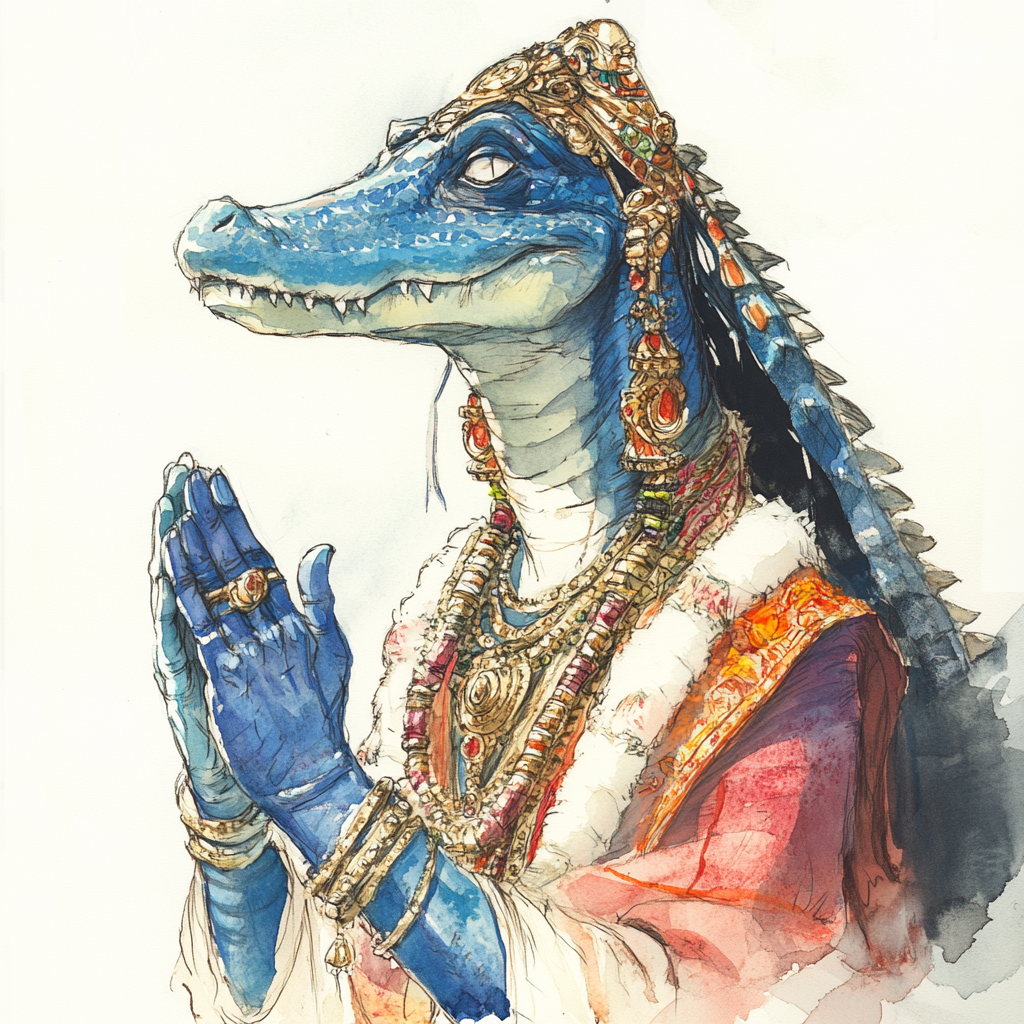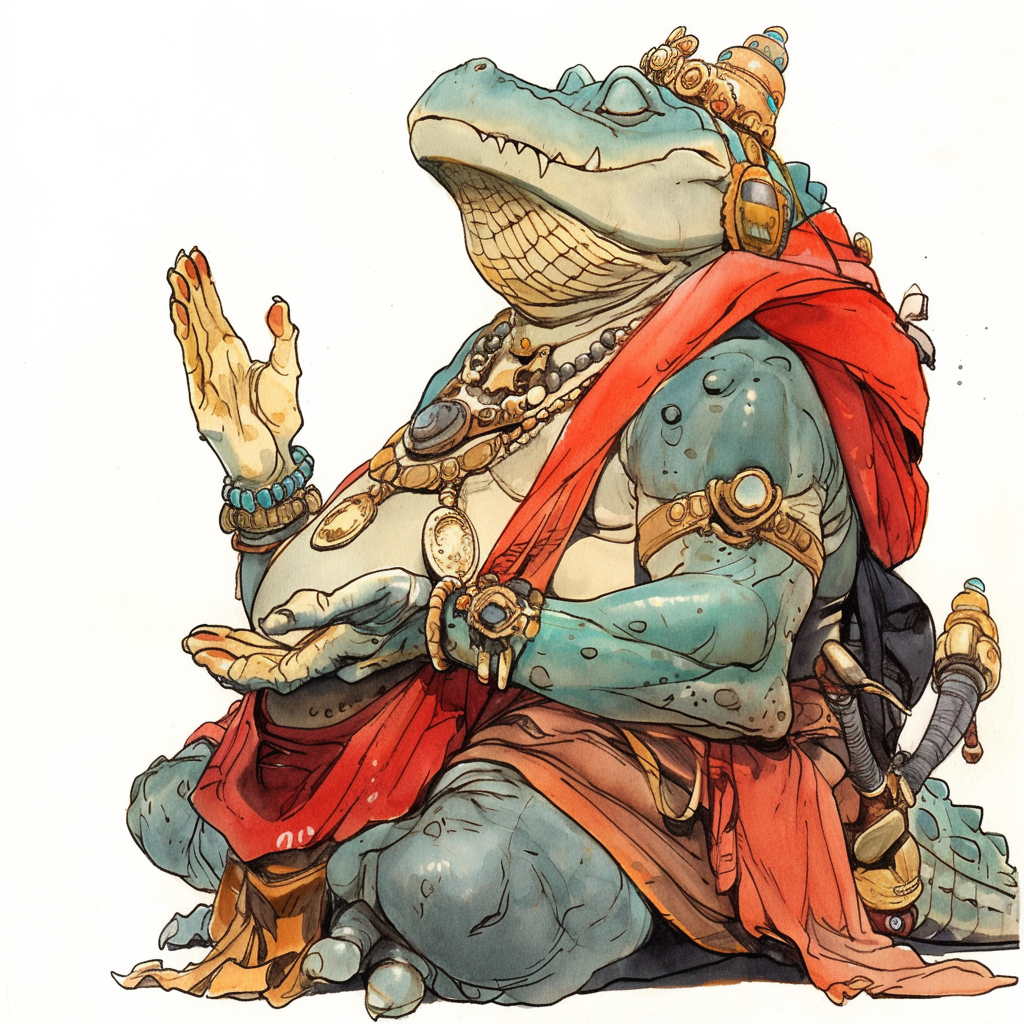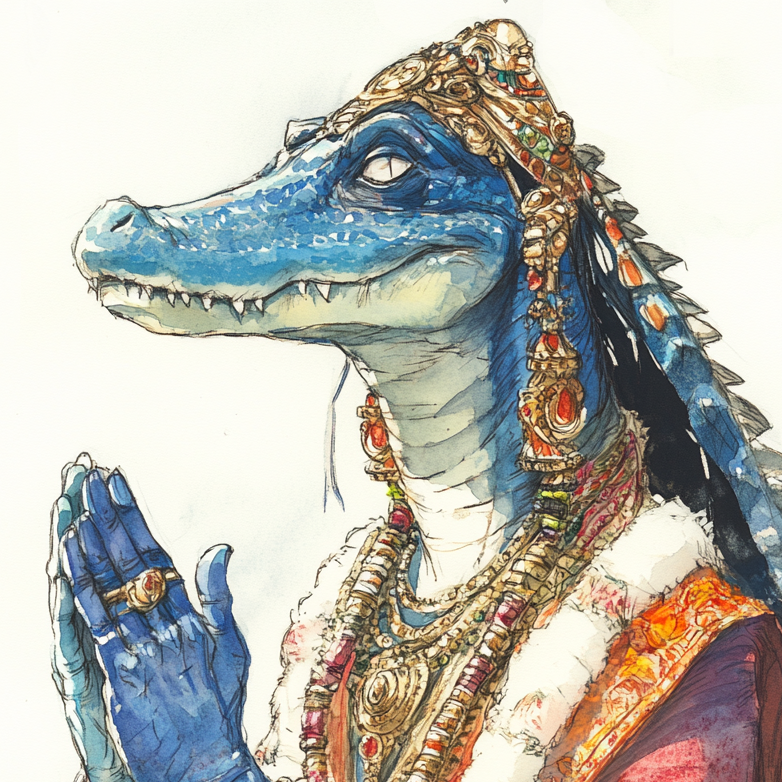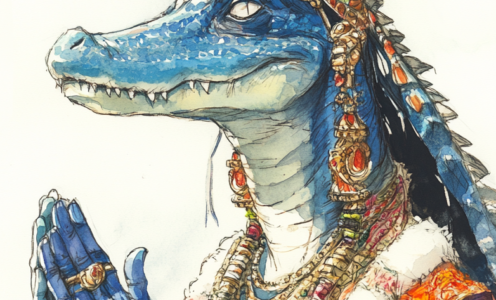Jala Rakshasa

Location: Mechanus / The Vigilant Eye
Game Statistics: Jala Rakshasa [Pathfinder 2e].
The Jala, or water rakshasas, are a unique offshoot of their fiendish rakshasa cousins, who are feared and hated in equal measures in lands where the Vedic pantheon holds sway. Unlike the tiger-headed rakshasas who revel in wickedness in their role as incarnations of moral corruption, the jala have been transformed into paragons of dharma, through the divine grace of Varuna. Jala are distinguishable by their crocodilian heads, which bear sharp, fearsome jaws and glistening yellow-green eyes—but their aggressive appearance belies their spiritual nature. Their powerful, scaled bodies shimmer with an iridescent sheen of aquatic hues, which lends them an aura of primal strength tempered by calm, contemplative wisdom. Jala are guardians of purity and cosmic order, forever bound to preserving the sanctity of sacred waters.
The Origin of the Jala
It is said that Varuna, the Lord of Cosmic Order, grew upset at the defilement of rivers and oceans and cast his noose into the primordial waters to cleanse them. When the noose returned, it pulled from the depths a group of rakshasas, who were tainted, but in the eyes of Varuna, redeemable. Seeing their potential, Varuna transformed them into his chosen enforcers, binding them to the dharma of water and balance. Physically, they took on the visage of Makara, Varuna’s mythical mount, merging the ferocity of a crocodile with the grace of water, as their role would require both strength and serenity.
This act of transformation, however, marked the jala as outcasts among their own kind. The fiendish rakshasas scorn them as traitors to their primordial purpose, believing their divergence is an unforgivable betrayal. The jala however, see their path not as rebellion but as true enlightenment. They are no longer bound by the cycle of villainy and death that ensnares their kin, but by the flowing currents of dharma itself. Their lives are dedicated to maintaining the purity of sacred waters, and by extension, all rivers and wells that spring from Varuna’s realm.
Philosophy of the Jala

The jala believe water embodies the essence of dharma. Water, to them, is a paradox: Life-giving and nurturing, yet capable of great destruction when unbalanced. Their mandate is to ensure that rivers flow unimpeded but also regulated, that oceans remain unpolluted but not stormy, and that the natural rhythm of wet season following dry season—are maintained as sacred and eternal.
Unlike their kin, jala do not revel in causing suffering, breaking taboos or exploiting mortals. Instead, they view mortals as participants in the cosmic cycle, to be guided and taught rather than corrupted. Their interventions are firm but proportionate: a gentle rebuke to those who hoard resources, a stern warning for those who deliberately disrupt the balance, a decisive punishment to those who poison the waters. For cutters who uphold dharma and respect the waters, the jala are steadfast allies, offering their blessings and aid in times of need.
Their approach to morality, like water itself, is fluid. They do not adhere strictly to the concepts of goodness or evil but instead strive for harmony and balance. They believe that both creation and destruction have their place, and their role is to ensure neither runs unchecked. This philosophy makes them powerful adjudicators in disputes over resources, water rights or natural boundaries. The jala are natural allies of aeons, and they are particularly fond of samsaran—those curious mortals who find themselves in a cycle of perpetual reincarnation,
Their Role in the Vigilant Eye
The jala are the fiercest and most loyal guardians of Varuna’s realm. They patrol cascades that flow between the plane’s great gears, ensuring that the flow of water—and by extension, the flow of dharma—remains unbroken. They are stationed at key points around the Cosmic Reservoir, the radiant lake at the heart of the realm, purifying its waters and defending it against any threat.
The jala may also act as emissaries of Varuna’s will, travelling to other planes to restore balance when water or dharma has been desecrated. They teach sacred rituals for water purification, advise rulers on the just use of natural resources, and serve as living examples of dharma in action. Some jala may even accompany mortals on perilous quests, acting as guides and protectors for those who seek to preserve balance.
Differences from Traditional Rakshasas
These beings serve a unique philosophical purpose as living embodiments of redemption, demonstrating to mortals that even those born into the most corrupt and profane roles can find a higher purpose by aligning themselves with dharma. Unlike their tiger-headed kin, who exist solely to demonstrate to mortals the consequences of wickedness by embodying everything foul, the jala exist to reveal how individuals and societies can cleanse themselves of impurities—both literal and moral—through living harmoniously, responsibility, and in the pursuit of balance.
The jala are not preachers; they are practitioners of dharma, teaching through their actions rather than rhetoric. When a river is poisoned, they do not simply chastise the perpetrators—they purify the waters and restore life to the surrounding land. Only in dire cases will they act with force, unleashing their crocodilian ferocity against those who persist in disrupting balance.
Varuna saw potential where others would have seen only despair. The evil rakshasas are fated to forever play the role of villain—yet, in the wickedness of their existence, there was also a kernel of possibility. Varuna recognised that even the darkest waters could be purified if their flow was redirected carefully, and thus demonstrated the path of dharma is not static—like water itself, it adapts. The jala were born from this insight, their existence proving to mortals the idea that redemption is possible—but only through discipline, responsibility, and service. Jala were not created to erase or replace their tiger-headed kin but to offer a complementary perspective.
See Also: Jala rakshasa game statistics here [Pathfinder 2e]. Find more information on the samsaran here, and on other kinds of rakshasa here.
Sources: Jon Winter-Holt



